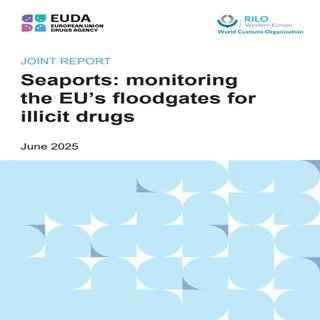By EUDA and the Regional Intelligence Liaison Office Western Europe (RILO-WE) of the World Customs Organization (WCO)
This report was prepared jointly by the European Union Drugs Agency (EUDA) and the Regional Intelligence Liaison Office Western Europe (RILO-WE) of the World Customs Organization (WCO), in order to support the European Ports Alliance Public Private Partnership (European Ports Alliance). To this end it provides an overview of seizures of drugs in or destined for EU seaports in the period from January 2019 to June 2024. As the report notes, there are significant gaps in the available data, which is a major barrier to developing a better understanding of the current situation and trends. As a result, the report’s findings need to be interpreted with a degree of caution. • Based on data provided by WCO RILO-WE, a total of 1 826 tonnes of drugs were seized at or in transit to EU seaports in the period between January 2019 and June 2024, out of which more than 1 244 tonnes were seized at EU ports (about 68 %). The data available indicates that the majority of the total quantity was seized from container ships (at least 1 507 tonnes, 82.6 % of the total). However, this is likely to be a significant underestimate of all drugs seized in or destined for EU ports during this period, due to the absence of data and gaps in reporting from several EU Member States. • Eighteen EU countries reported to the WCO on seizures carried out at a total of 96 EU ports (of which 40 are in Spain). However, the data submitted by these countries is not comprehensive, as some countries only reported a limited number of cases. For example, two key Member States only reported two cases each to the WCO during the five-and-a-half-year period in question, while the actual number of seizures in these countries during this time was much higher. • Among the 33 seaports that belong to the European Ports Alliance, nine appear not to report drug seizures to the WCO. The analysis also indicates that some seaports that are currently not members of the European Ports Alliance are significant targets for maritime drug trafficking. • Seventeen EU ports seized over 10 tonnes of drugs in this period, with Antwerp (BE) seizing the largest quantity (483 tonnes). • Cocaine appears to be the drug trafficked in the largest quantity to EU ports, with about 1 487 tonnes seized, representing 81.7 % of the total quantity of drugs in the dataset. Cannabis resin appears to be the second most trafficked drug, with about 260 tonnes seized, or 14.2 % of the total. For some drug types, only small numbers of seizures were reported (e.g. only 35 seizures of herbal cannabis were recorded). • The ports of Antwerp (BE) and Rotterdam (NL) seized the largest quantities of cocaine (about 443 tonnes and 181 tonnes respectively) and heroin (8.1 tonnes and 5 tonnes respectively). • The ports of Las Palmas de Gran Canaria (ES) and Huelva (ES) seized the largest quantities of cannabis resin (42 tonnes and 30 tonnes respectively). • The available data indicate that at least 21.7 tonnes of captagon were seized at EU seaports during this period. The majority came from one seizure in Salerno (IT) in 2020 (14.2 tonnes). It is noteworthy that no captagon seizures were reported to the WCO in EU ports after 2020. • The large quantities of drugs seized on average per shipment — more than 500 kilograms of cocaine and more than 1.3 tonnes of cannabis resin — and in total during the period, confirm that criminal networks are still able to use EU ports to smuggle wholesale amounts of various drugs, especially cocaine. This in turn indicates that EU ports are infiltrated by organised criminal networks to a significant degree, implying the likely corruption among port staff including port workers and law enforcement officials. In addition, violence has been observed in connection with drug smuggling in many EU ports.
Luxembourg: Publications Office of the European Union, 2025 2025. 32p






